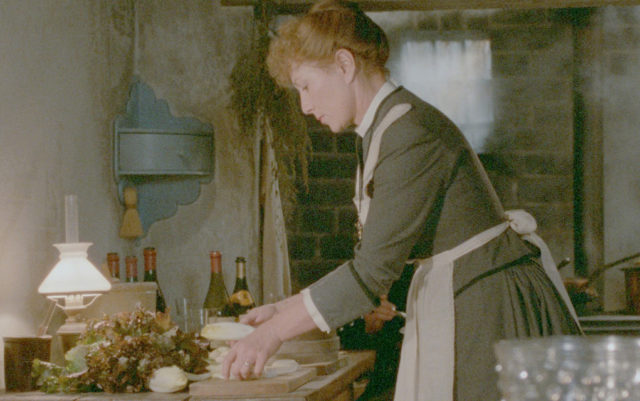
General Lorens Löwenhielm (Jarl Kulle), a middle-aged man with a lifetime of missed opportunities behind him, has come to dinner. Seated next to his aunt, and two chairs away from an old flame, the general is surrounded by nine others, all dressed in black, saying little and smiling less.
He takes a sip of the soup: turtle soup, phenomenal turtle soup. No one else at the table bats an eye. Then comes the Champagne, and not just any Champagne, but 1860 Veuve Clicquot. The general taps his neighbor on the shoulder.
“I’m sure this is Veuve Clicquot,” he whispers.
“Yes, it is,” the man nods without a hint of emotion.
The general is flabbergasted: this is a remote seaside Danish village with about a dozen buildings and just as many residents; how in the world could they get such exquisite Champagne? And who is making this extraordinary soup?
Welcome to Babette’s Feast, a 1987 Danish film adapted from Karen Blixen’s short story of the same name. Blixen gained currency in the film world when Sidney Pollack adapted her memoir Out of Africa with Robert Redford and Meryl Streep in 1985, but Babette is easily her greatest contribution to the cinematic arts.
Babette’s Feast is, first and foremost, a delightful masterpiece. Director Gabriel Axel deviates from Blixen’s story only slightly, mostly rounding off her hard edges while retaining the spirit underneath. A spirit bolstered by cinematographer Henning Kristiansen, who turns every image into a Vermeer painting. If good art borrows while the best art steals, then the greatest art transforms.
Though the title belongs to Babette (Stéphane Audran), a renowned French chef in exile, Babette’s Feast centers on two sisters: Filippa (Bodil Kjer) and Martine (Birgitte Federspiel), daughters of a widowed pastor and prophet. All who inhabit this tiny village count themselves as disciples of the pastor, adhering to austerity levels even a monk would question.
Enter Babette, a refugee seeking sanctuary on a dark and stormy night. Though the sisters don’t need a cook — their meals consisting primarily of stale bread soaked in ale and cooked down into a slop fit for neither man nor beast — Christian charity forbids they turn the stranger out. And so, Babette comes to be the sister’s cook. Then, a twist: Babette wins the French lottery, 10,000 francs. What to do with the money? She’ll prepare a feast, a full French feast to celebrate the centennial of the sisters’ father. Not exactly what the sisters had in mind, but Babette insists on repaying their kindness. The sisters relent and what happens next is nothing short of a miracle.
Babette’s Feast is quite possibly the only food film where you can enter the theater hungry and leave full. As Babette transforms the raw ingredients of animal and plant into a sumptuous meal, the diners are equally transformed. The villagers bury old grudges. The general proclaims, “Mercy and truth have met together.” They sing hymns and dance off into the night. And we exit the theater feeling full and satisfied, though we haven’t eaten a single thing. Such is the power of true art.
On the Bill: Babette’s Feast — Homage to Anthony Bourdain at the Flatirons Food Film Festival. 6 p.m. Saturday, Oct. 13, Boulder Public Library, Canyon Theater, 1001 Arapahoe Ave., Boulder, flatironsfoodfilmfest.org/2018/08/homage-to-anthony-bourdain/














